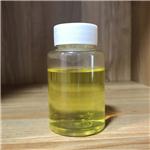Chemical Properties
3-Bromofuran is a colorless to light yellow liquid having a boiling point similar to that of water (102.5-102.6 °C), but with density significantly higher (1.6606 g/cm3 at 20 °C).It is colorless when it is pure; however, the color can be light yellow when minor impurities are present. It is usaually stablized by calcium carbonate. It was used in the preparation of 2-substituted 3-furfurals. It was also used in the synthesis of 5,6-dehydronorcantharidins. 3-bromofuran is one of the volatile metabolites discussed in studies for detecting and discriminating diseases of onion.
Uses
3-Bromofuran is heterocyclic building block used in organic synthesis. 3-Bromofuran is one of the volatile metabolites discussed in studies for detecting and discriminating diseases of onion.
Synthesis
3-Bromofuran was obtained in minor amounts in 1887 as a byproduct in a reaction of 3-bromofuroic acid with calcium hydroxide. About four decades later this compound was prepared deliberately and in higher yield. 3-bromofuran has been prepared from 3,4-dibromofuran via ortho-metalation with butyl lithium in good yield. An elegant synthesis of 3-bromofuran is due to Fechtel who prepared this compound via a Diels Alder-bromination-reverse Diels Alder sequence.
Purification Methods
Purify 3-bromofuran by two steam distillations and dry it over fresh CaO. It can be dried over Na metal (no obvious reaction) and fractionated. It is not very soluble in H2O but is soluble in organic solvents. When freshly distilled, it is a clear oil, but darkens on standing and eventually resinifies. It can be stored for long periods by covering the oil with an alkaline solution of hydroquinone and is redistilled when required. It forms a characteristic maleic anhydride adduct, m 131.5-132o. [Shepard et al. J Am Chem Soc 52 2083 1930, Huhes & Johnson J Am Chem Soc 53 737 1931, adduct: van Campen & Johnson J Am Chem Soc 55 430 1933, Beilstein 17/1 V 295.]




